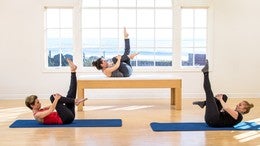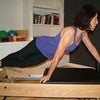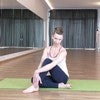Description
About This Video
Transcript
Read Full Transcript
Hello, my name is Jennifer Golden Zuman and today I am sharing with you a tutorial about the front of the back. This is really a second part to a tutorial that I gave previously about the front of the back in which I specifically focused on everything from the diaphragm down. Today I'm going to talk about what's happening inside the body in the diaphragm up. So the idea of the front of the back, we have to think about that for a moment to talk about exactly what location we're considering. So we've got the front of our front right, we've got the back of our back, and then in here is the front of our back. And a lot of our very important attachments, both fascially and muscularly and viscerally our organs have to do with a lot of this space that's between the back and the front. So in order to understand those relationships in the body, we have to consider what is in what's inside this area.
So let's just start by talking about the diaphragm here. Our diaphragm starts attached down here at these lowest ribs in the back, and it actually attaches all the way around the inside of the rib cage. Now underneath it is our whole massive organs and all this stuff, which we're not gonna talk about right now, but above it we also have a lot of very interesting attachments. So right inside, right inside the ribcage here we've got a layer of Fascia, which is called the Endo Thoracic Fascia. So that means NGO is inside and Thoracic, which is our thorax.
Our thorax could be defined by these 12 vertebrae. You know there are thoracic vertebrae, B Vertebra, because they each have a rib attached to them. And that's how you know it's a thoracic vertebra. And the each rib attaches around to the sternum to form that thoracic cage. So the whole area from the ribs up top to the ribs down below, this is our thorax.
And inside of that is an entire lining of Fascia called our Endo Thoracic Fatia. That pref provides a fluid sheaf inside here to provide some movement and to provide to reduce friction and allows some flexibility to create a barrier also between the bones and then the organs inside. So let's continue now talking about those organs inside right up on top of our diaphragm. Well this is interesting cause I don't know if a lot of people always realize that our heart is sitting right on top of the diaphragm and fashionably. They're very connected to each other. So as we breathe, inhaling, the diaphragm spreads out and flattens.
Creating some wit in the base of our thoracic cage. The heart is descending down with it. Okay. Now we're going to talk a little bit about where else that heart is attached. Around the heart is another bag that's called our pericardium in Chinese medicine. Pericardium is called the heart protector, so it's a bag which helps to regulate pressure. That is where the heart muscle is inside.
That pericardial bag helps to regulate some pressure and create some protection. The fascia of the pericardium Fascia around that pericardium actually connects all the way up and is related to the Fascia of the scalene muscles of the neck. Okay, that was a lot that I just said and I just wonder through the body. So let's talk about that a little bit closer. The scalene muscles of your neck, if you put your hand right here and you find your, um, your collarbone, so feel your collarbone, your clavicle right here. And if you let your finger drop right beneath that, then right at these top ribs that are hiding sort of underneath your collarbone, you pin that down and you tip your head away.
You can feel your scalene muscles. The scalene muscles are kind of akin to, I consider them looking sort of like the, so as of the neck, although that is not a scientific fact, that's just me saying that. The reason I say that is because they attach to the, to the side of the neck here and then they span out from these cervical vertebrae span out to these first and second rib down here. So they go from the spine and then they continue out and extend down here. But inside the Fascia that the scalene is contained within, continues inside the thoracic cage and helps to form the fashional sheath, which then completely invests in forms and part of the pericardium.
Why is that important? That's important in what we're doing because as we turn our head and as we make movements with our neck, which involve our scalings, it's significant to acknowledge that there's a fashionable relationship all the way down inside our center, down to the heart. So now that we've looked at this inner connection right here, let's talk a little bit about those thoracic vertebrae. These thoracic vertebrae, each angle downwards, they're almost like shingles, one folding over the other, so they create a kyphosis or a curvature outwards creating a rounded shape of that thoracic spine. So that is important to the shape of our rib cage.
Now inside on the front, we've got, let's continue with a few more. Oregon's. So our heart is sitting here on top of our diaphragm. Then we've got a space in the middle and this is space where our trachea and our Esophagus, our breathing tube and our eating tubes come down the middle and there's a space in the middle that's called the media Steinle space. That's the space in the middle of the two sides of where the lungs are on either side here. So again, just like the heart has the heart protector, the lungs have a pleural sac, they have the pleura around the lungs, which helps to regulate the pressure and provide a host of other benefits for the lungs or functions for the lungs. But right now we'll just talk about the fact that they are a bag.
So you've got the Endo Thoracic Fascia, then you've got the Pleura, then you've got the lung tissue. There's a lot more in there. But to simplify things, let's look at it that way. So on each side you've got a lung and in the middle you've got your tubes that feed down and continue with those come through your diaphragm and continue to all their continued tubes where they need to go. Well, the trachea spreads out to the lungs, but the gut ones comes through and then we're going to ignore for now what happens down there at that point. Um, but the heart and the lungs also have attachments to the back of the Thoracic Wall and those are attached via what's called suspensory ligaments. So those suspensory ligaments hold them in place, so they're not just floating freely around inside the thorax, but they're packed together and they're anchored into the back wall by some suspensory ligaments. So the positioning of our thoracic vertebrae, the freedom of our ribcage and our thoracic spine affect the rigidity of those ligaments as well as things like asthma or things that create a tensioning in the viscera can also affect the ligaments and affect the posture.
So that's helpful when we're considering our queuing and our understanding of someone's body. When you see maybe someone has a collapsed chest or maybe they seem really rigid in that upper spine and you can't figure out why, it's helpful to know perhaps that they have a history of asthma. So even if they're starting to breathe deeper, there may be a um, inhibition through those suspensory ligaments that can create almost a pulling down or a rigidity through that upper spine. Let's continue to talk about a rigidity or freedom of the thorax by starting to look at the rib cage as a series of rings. So we'll call these rib rings.
Up at the top we've got rib number one and that's a ring all the way down each ring. The bottom ones here are kind of imaginary rings, but you can still imagine them this way as rings. So we imagined perhaps like a series of dinner plates and the freedom of those ribs to respond to our movement and the freedom of them to restack themselves and organize themselves is very important for effective load transmission. It's also often a reason for having some ineffective load at transmissions. Having a, what we'll call failed load transfer. So what does mean exactly? Failed or successful load transfer.
That means the ability for the weight of the upper body and response to the ground force reaction to transfer the loads as needed to maintain stability in the pelvis or to maintain strength in the body as we move. So this is important to consider because a lot of times we feel effects in other places like our [inaudible] joints. People feel like achy down here or a problem in their knee or a problem in the hip. And what's really happening is there may be not transferring load effectively and oftentimes that can be looked at or adjusted through the ribs and through the rib rings. So if our ribs are tight, then we are not utilizing the many joints that are available to distribute load and change it if we're not stable, if it's too Wigley, that may be the opposite problem as well. So let's think about how that affects our movement when we move our arms, when we lift our arms up, each of the ribs should rise up a little bit with it.
If they don't, then the ribs are staying, staying down and we're not transferring the load as it's intended to transfer through the body. Each of the ribs should move as we move our arms. That brings us along as well to talking about the clavicles and collarbones here. So our clavicles should rise up and our scapula should swing and move along with our rib cage. So if you can imagine even just on an inhalation, these upper rings would lift and open, the collarbones would lift a little bit and the scapula would float upwards a little bit. This is where we can acknowledge a couple of pitfalls we could fall into in our [inaudible] teaching. So here's a couple of potential pitfalls. We will not get healthy rib motion, which affects the inside and the outside of our rib cage.
If we are keeping our collarbones and shoulder blades down. So many of us perhaps have been taught in a perspective or maybe we came from a dance background, sometimes two in which we are taught to keep our shoulder blades anchored down or keep our clavicles down. Try to keep this area level or even slightly angled downwards. When we do that, what we're doing is we're compressing down the sides of our clavicles and I want you to take a little notice here to see how these upper rib rings. These upper two are slightly tipped forward just slightly because that's part of that shape of the thoracic spine. If they get dragged further down, that brings the sternum back towards the spine.
It compresses all of the fashion relationships in are in here, the neck gets dragged forward, and now we have this very deep stuck position in the neck through the rib cage, and that affects, of course, everything going on down below. So the solution to that is to consider each of these rings stacked upright and to allow those collarbones to stay up when we lift the arms, when we move the arms in any way, the collarbones should ve upwards with that motion and allow those rib rings to float upwards. We also want to consider the way the ribs attach in the back to the spine. So I just heard an absolutely phenomenal visualization from this. From Irene doubt.
This is the most beautiful way that I have heard this described. And she talked about, especially these upper two. She said, imagine that you're wearing a necklace, that the rib ring is a necklace. So from the sternum in the front you attach it around into the back and you feel it clasp right up at the Vertebra is where it clasps. So just take a moment right now to imagine that in your own body. So when you take a breath in, feel it float up effortlessly, and then just visualize that you bring that clasp around and you just class that right in at those vertebrae.
So it's not really a question of how far forward or backwards we're coming up, how high we're lifting the chest, or how much we're using the shoulders or not. It's really a question of finding this transverse connection of each rib up against it's connected vertebra to help keep some integrity in the rib cage. So now let's talk about the next potential pitfall, which is actually somewhat related, which is a question of flattening or pulling the rib cage down. Sometimes in Pilati is when we exhale, we squeeze just a little bit too hard and we use our oblique muscles and we drag the rib cage down towards the pelvis. So if you want to take a look for a moment and see what I mean by example here.
So if I exhale and I overuse my obliques, just take a look what happens here. So just imagine, let me do it a couple more times. I want you to imagine what is happening now that you can picture my lungs, my heart, my real goal is for you to have a three dimensional picture of what's happening inside. I think we get a lot of anatomy study about what's happening outside, but not enough about what's happening inside. So just imagine me looking like this full of Oregon's full stuff, full of all kinds of things in there. And I'm going to show you and you visualize what's happening internally.
As I do that
So when I inhale, imagine now my diaphragm attached to my heart right on top of it. And as I inhale, my diaphragm is descending, drawing the heart with it, which is elongating my neck because it's attached to the Fascia there. And as I exhale, the elasticity of my lungs returns to its original state state, my heart rises back up and I continue to have a nice relaxed sensation in my neck. And now as I move my arms, if I bring my arms back and back up, my arms are taking along with it. The fascia that is continued to be attached.
So from that neck here, we started to talk about that attachment down to the pericardium, but also we have what's called the brachial plexus. And the brachial plexus is right around this area. It's a convergence place where a lot of our nerves and blood vessels run through this little tunnel right through here. And it's a place of, um, a lot of activity. So that area is also surrounded by a fashional sheath, which is continuous with this fascicle sheet that's in the endo thoracic. So as we move our arms, we are stimulating the outside of the rib cage, but we're also stimulating the inside of our rib cage.
So picture a very interesting exercise
Comments
You need to be a subscriber to post a comment.
Please Log In or Create an Account to start your free trial.





















